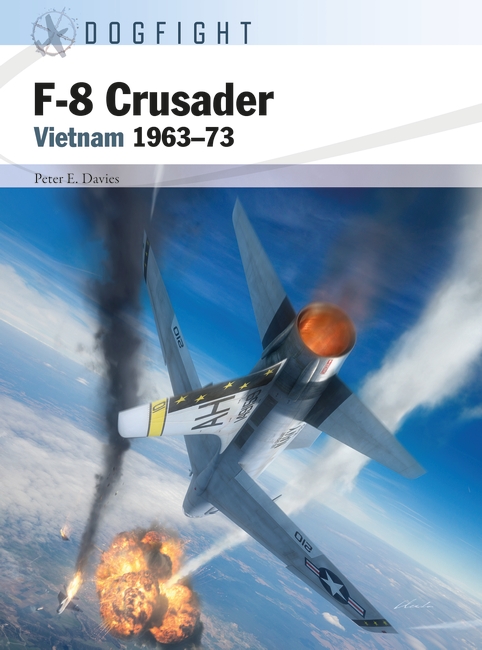
The term “classic fighter” is hard to define but it surely implies a highly successful and innovative design, a record of aerial victories, and popularity with some ace pilots. Add spectacular performance and memorable good looks to that list and you have the F-8 Crusader. Above all, its place in combat aircraft history is marked by its popular identity as the “Last of the Gunfighters.”
The F-8 Crusader’s reputation was certainly well established in the memories of the former MiG killer pilots that I was fortunate enough to interview for this book. For Phil Vampatella, it was “a wonderful airplane [that] would really hurt you if you mistreated it, but everybody who flew it loved it.” Jerry “Devil” Houston believed that it “stole your heart from the get-go with its beauty and, for its time, power.” Dick Schaffert gives a memorable account of his ten-minute battle with ten MiG-17s and MiG-21s, during which he repeatedly pushed his F-8C to the limits of its maneuverability and speed in defending an Iron Hand A-4E Skyhawk. He was later awarded the Distinguished Flying Cross for his outstanding piloting. Dogfights involving the other Crusader crewmen are also examined in detail in the book. Tactics and armament are described using comments from pilots and some eye-catching illustrations by expert artists Gareth Hector, Jim Laurier, and Tim Brown.
Like the F-104 Starfighter, the Crusader was conceived as a response to the unexpectedly successful performance of the Soviet MiG-15 in Korea. The US Navy wanted a fighter that would clearly outclass and outrun the MiG. Its designers took advantage of the availability of the outstanding Pratt & Whitney J57 afterburning engine, an airframe with low transonic drag, and a unique high-mounted wing that could be raised at the leading edge to enable the supersonic fighter to attain low speeds and a suitable angle of attack for carrier landings. In its F-8E (and later) versions, it could carry a useful load of air-to-ground ordnance, making it a valued close support weapon for the US Marines.
The Crusader became the US Navy’s “day fighter” from 1956, equipping nine squadrons on Task Force 77 carriers fighting the Vietnam War up to 1970. By that time, the two-seat F-4 Phantom had replaced all but three units – these continued to operate F-8s from the smaller Essex-class carriers.
F-8 pilots, unlike their F-4 counterparts, had specialized in training for old-school dogfighting when they deployed to Vietnam and they took on North Vietnam’s MiG-17s in numerous air battles from June 1966 until May 1972. Many of these clashes developed into complex, close-quarters dogfights (illustrated in the book with ribbon diagrams) in which the Crusaders were able to maneuver with the MiGs more effectively than Phantoms could. Later in the war, F-8 pilots would pass on their dogfighting skills to both US Navy and USAF Phantom crews. Pilots who eventually transitioned to the F-4, like “Devil” Houston, were able to bring their experience to bear on the heavier, twin-engined F-4, scoring more MiG kills. The founding of the Top Gun Fighter Weapons School at NAS Miramar in 1969 owed much to experienced F-8 pilots adapting their hard-won dogfighting skills to F-4 training initiatives.
Although the F-8 relied on its main armament, a standard US Navy quartet of 20mm guns, its guns were involved in only three of its 19 MiG kills, with the majority being scored by AIM-9D Sidewinder missiles. The guns did not react well to the F-8 pilots’ high-speed, high-g combat maneuvering. Jammed ammunition feeds were a frustratingly common cause of missed MiG kill opportunities throughout the war.
However, despite the F-4’s heavier missile armament and increasingly superior numbers, the F-8 pilots’ success rate against MiGs was more impressive. It was widely believed that MiG pilots avoided Crusaders whenever possible. In 1968, F-8 pilots shot down five of the six MiGs destroyed by USN fighters, building upon their record of scoring 14 of the Navy’s 29 kills from 1965–67. In May 1967, Crusaders scored all five USN aerial victories, four of them in a single day.
Crusader pilots were a special breed who continued to fight with the well-honed air-to-air tactics developed during two world wars and the Korean conflict. Their training equipped them to face nimble, hard-hitting North Vietnamese MiGs when the fighter world was preoccupied with long-range missiles and automated interceptions. As “Devil” Houston put it: “Everything funnelled the best pilots and the best airplanes through a narrow training “spout” and out popped the world’s best fighter pilots. They all ate, breathed, [and] thought and dreamed about fighting airplanes. All the time.”
F-8 Crusader has been a most enjoyable opportunity to explore and record these pilots’ achievements and to evaluate the Crusader as a key factor in the hard-fought air war over Vietnam.

Comments
You must be logged in to comment on this post. Click here to log in.
Submit your comment